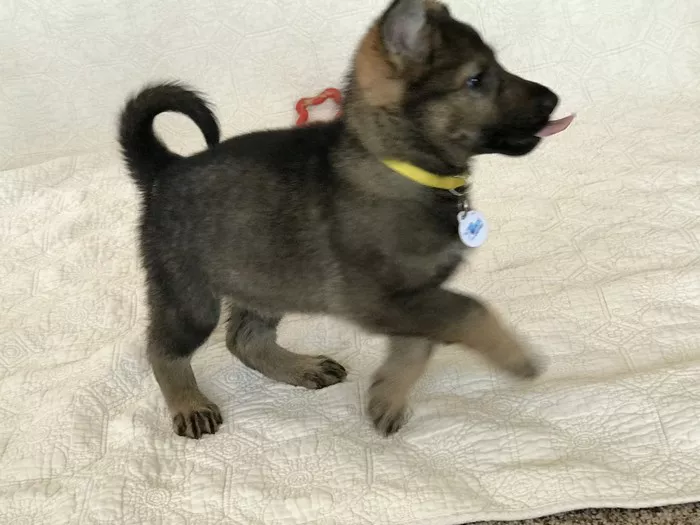Bringing a German Shepherd puppy into your home is an exciting venture, but it comes with the responsibility of toilet training. Potty training is a crucial aspect of a puppy’s early development, and for German Shepherds, known for their intelligence and trainability, the process can be streamlined with effective strategies. In this comprehensive guide, we will explore seven distribution ways for German Shepherd puppies to learn toilet training, covering prevention techniques, crate training, monitoring behavior, the use of puppy pads, establishing routines, recognizing potty cues, and preventing accidents.
Prevention is Key
Establish a Routine: One of the key aspects of preventing accidents is to establish a routine for your German Shepherd puppy. Consistency in feeding, playtime, and potty breaks helps regulate their bathroom habits and reduces the likelihood of accidents.
Supervision: Prevention starts with vigilant supervision. Keep a close eye on your German Shepherd puppy, especially during times when they are likely to need to eliminate, such as after meals or waking up from a nap.
Limit Access: To prevent accidents, limit your puppy’s access to certain areas of the house. This controlled environment reduces the chances of them finding a secluded spot to relieve themselves.
Teach Them to Love Their Crate
Crate Training Introduction: Introduce your German Shepherd puppy to crate training early on. Dogs generally avoid soiling their living space, making a crate a valuable tool for encouraging them to hold it until they’re outside.
Positive Association with Crate: Create a positive association with the crate by placing treats, toys, and comfortable bedding inside. Make it a safe and enjoyable space where your puppy feels secure.
Gradual Increase in Crate Time: Gradually increase the amount of time your German Shepherd spends in the crate. Start with short intervals and gradually extend the duration as they become more comfortable. This helps them build bladder control.
Monitor Your Puppy’s Behavior
Recognize Potty Cues: German Shepherds, like all puppies, exhibit specific behaviors when they need to go. Common cues include sniffing the ground, circling, or suddenly becoming restless. Pay attention to these signs for timely bathroom breaks.
Supervise Indoor Activities: When indoors, closely supervise your German Shepherd puppy, especially during periods when they are likely to need to eliminate. If you observe any signs of needing to go, immediately take them outside.
Use Puppy Pads
Introduction to Puppy Pads: Puppy pads can be a useful tool for toilet training, especially during the early stages. Introduce your German Shepherd puppy to puppy pads placed in a designated area indoors.
Positive Reinforcement: Use positive reinforcement when your puppy uses the puppy pad correctly. Verbal praise and treats create a positive association with the designated area, encouraging them to use it consistently.
Gradual Transition: As your German Shepherd puppy becomes more reliable with using puppy pads, gradually transition them to outdoor bathroom breaks. Move the puppy pads closer to the door and eventually take them outside when they signal the need to go.
Teach Them a Potty Routine
Consistent Outdoor Schedule: Establish a consistent schedule for outdoor potty breaks. Take your German Shepherd puppy outside first thing in the morning, after meals, and before bedtime. Consistency reinforces the idea of where they should go.
Positive Reinforcement for Outdoor Success: When your puppy goes to the bathroom outside, provide immediate positive reinforcement. Use treats, verbal praise, and affection to create a positive association with outdoor bathroom breaks.
Designated Outdoor Area: Designate a specific outdoor area for your German Shepherd puppy to relieve themselves. Consistently taking them to the same spot helps reinforce the idea that this is the appropriate place for elimination.
Know Your Puppy’s Potty Dance
Observe Individual Cues: Each German Shepherd puppy may have unique cues or behaviors indicating the need to go. Get to know your puppy’s specific signals, whether it’s pacing, whining, or a certain body posture.
Act Promptly: When you recognize your puppy’s potty dance, act promptly. Take them outside to the designated bathroom area to reinforce the association between the behavior and the appropriate place.
Positive Reinforcement: Reward your German Shepherd puppy for signaling their need to go outside. Positive reinforcement encourages them to communicate effectively and strengthens the bond between you and your puppy.
Add in a Cue
Choose a Cue Word: Select a cue word or phrase that you consistently use when taking your German Shepherd puppy outside. This could be something like “Go potty” or “Do your business.” The cue helps them associate the action with the command.
Use the Cue Consistently: Every time you take your puppy outside for a bathroom break, use the cue word. Consistency helps them understand the purpose of the outing and reinforces the desired behavior.
Immediate Positive Reinforcement: When your German Shepherd puppy follows the cue and goes to the bathroom outside, provide immediate positive reinforcement. Use treats, praise, and affection to reward the behavior.
Prevent Accidents
Regular Bathroom Breaks: To prevent accidents, maintain a regular schedule of bathroom breaks for your German Shepherd puppy. This includes taking them outside after meals, upon waking, and before bedtime.
Supervise Indoor Time: When your puppy is indoors, supervise their activities to prevent accidents. Use gates or close doors to limit their access to certain areas, especially if you cannot closely monitor their behavior.
Immediate Cleanup: If accidents occur indoors, clean the area immediately and thoroughly. Use an enzymatic cleaner to remove scent markers, minimizing the likelihood of your puppy repeating the behavior in the same spot.
Conclusion
In conclusion, toilet training your German Shepherd puppy is a journey that requires a combination of prevention, positive reinforcement, and understanding your puppy’s individual cues. By establishing routines, utilizing crate training, monitoring behavior, incorporating puppy pads, teaching a potty routine, recognizing cues, adding a verbal cue, and preventing accidents, you can foster successful toilet training.


